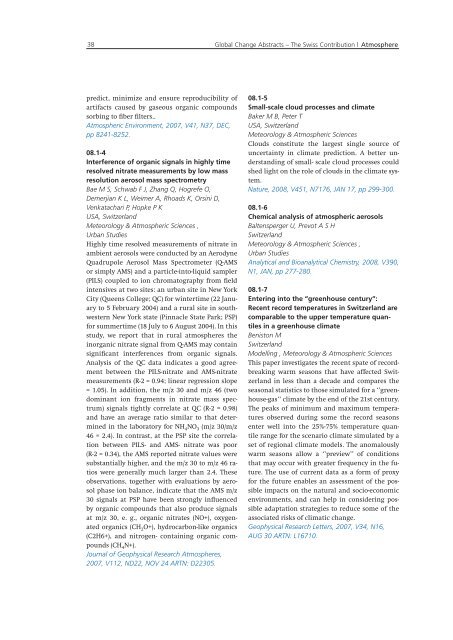Global Change Abstracts The Swiss Contribution - SCNAT
Global Change Abstracts The Swiss Contribution - SCNAT
Global Change Abstracts The Swiss Contribution - SCNAT
Create successful ePaper yourself
Turn your PDF publications into a flip-book with our unique Google optimized e-Paper software.
38<br />
predict, minimize and ensure reproducibility of<br />
artifacts caused by gaseous organic compounds<br />
sorbing to fiber filters..<br />
Atmospheric Environment, 2007, V41, N37, DEC,<br />
pp 8241-8252.<br />
08.1-4<br />
Interference of organic signals in highly time<br />
resolved nitrate measurements by low mass<br />
resolution aerosol mass spectrometry<br />
Bae M S, Schwab F J, Zhang Q, Hogrefe O,<br />
Demerjian K L, Weimer A, Rhoads K, Orsini D,<br />
Venkatachari P, Hopke P K<br />
USA, Switzerland<br />
Meteorology & Atmospheric Sciences ,<br />
Urban Studies<br />
Highly time resolved measurements of nitrate in<br />
ambient aerosols were conducted by an Aerodyne<br />
Quadrupole Aerosol Mass Spectrometer (Q-AMS<br />
or simply AMS) and a particle-into-liquid sampler<br />
(PILS) coupled to ion chromatography from field<br />
intensives at two sites: an urban site in New York<br />
City (Queens College; QC) for wintertime (22 January<br />
to 5 February 2004) and a rural site in southwestern<br />
New York state (Pinnacle State Park; PSP)<br />
for summertime (18 July to 6 August 2004). In this<br />
study, we report that in rural atmospheres the<br />
inorganic nitrate signal from Q-AMS may contain<br />
significant interferences from organic signals.<br />
Analysis of the QC data indicates a good agreement<br />
between the PILS-nitrate and AMS-nitrate<br />
measurements (R-2 = 0.94; linear regression slope<br />
= 1.05). In addition, the m/z 30 and m/z 46 (two<br />
dominant ion fragments in nitrate mass spectrum)<br />
signals tightly correlate at QC (R-2 = 0.98)<br />
and have an average ratio similar to that determined<br />
in the laboratory for NH 4NO 3 (m/z 30/m/z<br />
46 = 2.4). In contrast, at the PSP site the correlation<br />
between PILS- and AMS- nitrate was poor<br />
(R-2 = 0.34), the AMS reported nitrate values were<br />
substantially higher, and the m/z 30 to m/z 46 ratios<br />
were generally much larger than 2.4. <strong>The</strong>se<br />
observations, together with evaluations by aerosol<br />
phase ion balance, indicate that the AMS m/z<br />
30 signals at PSP have been strongly influenced<br />
by organic compounds that also produce signals<br />
at m/z 30, e. g., organic nitrates (NO+), oxygenated<br />
organics (CH 2O+), hydrocarbon-like organics<br />
(C2H6+), and nitrogen- containing organic compounds<br />
(CH 4N+).<br />
Journal of Geophysical Research Atmospheres,<br />
2007, V112, ND22, NOV 24 ARTN: D22305.<br />
<strong>Global</strong> <strong>Change</strong> <strong>Abstracts</strong> – <strong>The</strong> <strong>Swiss</strong> <strong>Contribution</strong> | Atmosphere<br />
08.1-5<br />
Small-scale cloud processes and climate<br />
Baker M B, Peter T<br />
USA, Switzerland<br />
Meteorology & Atmospheric Sciences<br />
Clouds constitute the largest single source of<br />
uncertainty in climate prediction. A better understanding<br />
of small- scale cloud processes could<br />
shed light on the role of clouds in the climate system.<br />
Nature, 2008, V451, N7176, JAN 17, pp 299-300.<br />
08.1-6<br />
Chemical analysis of atmospheric aerosols<br />
Baltensperger U, Prevot A S H<br />
Switzerland<br />
Meteorology & Atmospheric Sciences ,<br />
Urban Studies<br />
Analytical and Bioanalytical Chemistry, 2008, V390,<br />
N1, JAN, pp 277-280.<br />
08.1-7<br />
Entering into the “greenhouse century”:<br />
Recent record temperatures in Switzerland are<br />
comparable to the upper temperature quantiles<br />
in a greenhouse climate<br />
Beniston M<br />
Switzerland<br />
Modelling , Meteorology & Atmospheric Sciences<br />
This paper investigates the recent spate of recordbreaking<br />
warm seasons that have affected Switzerland<br />
in less than a decade and compares the<br />
seasonal statistics to those simulated for a ‘’greenhouse-gas’’<br />
climate by the end of the 21st century.<br />
<strong>The</strong> peaks of minimum and maximum temperatures<br />
observed during some the record seasons<br />
enter well into the 25%-75% temperature quantile<br />
range for the scenario climate simulated by a<br />
set of regional climate models. <strong>The</strong> anomalously<br />
warm seasons allow a ‘’preview’’ of conditions<br />
that may occur with greater frequency in the future.<br />
<strong>The</strong> use of current data as a form of proxy<br />
for the future enables an assessment of the possible<br />
impacts on the natural and socio-economic<br />
environments, and can help in considering possible<br />
adaptation strategies to reduce some of the<br />
associated risks of climatic change.<br />
Geophysical Research Letters, 2007, V34, N16,<br />
AUG 30 ARTN: L16710.

















